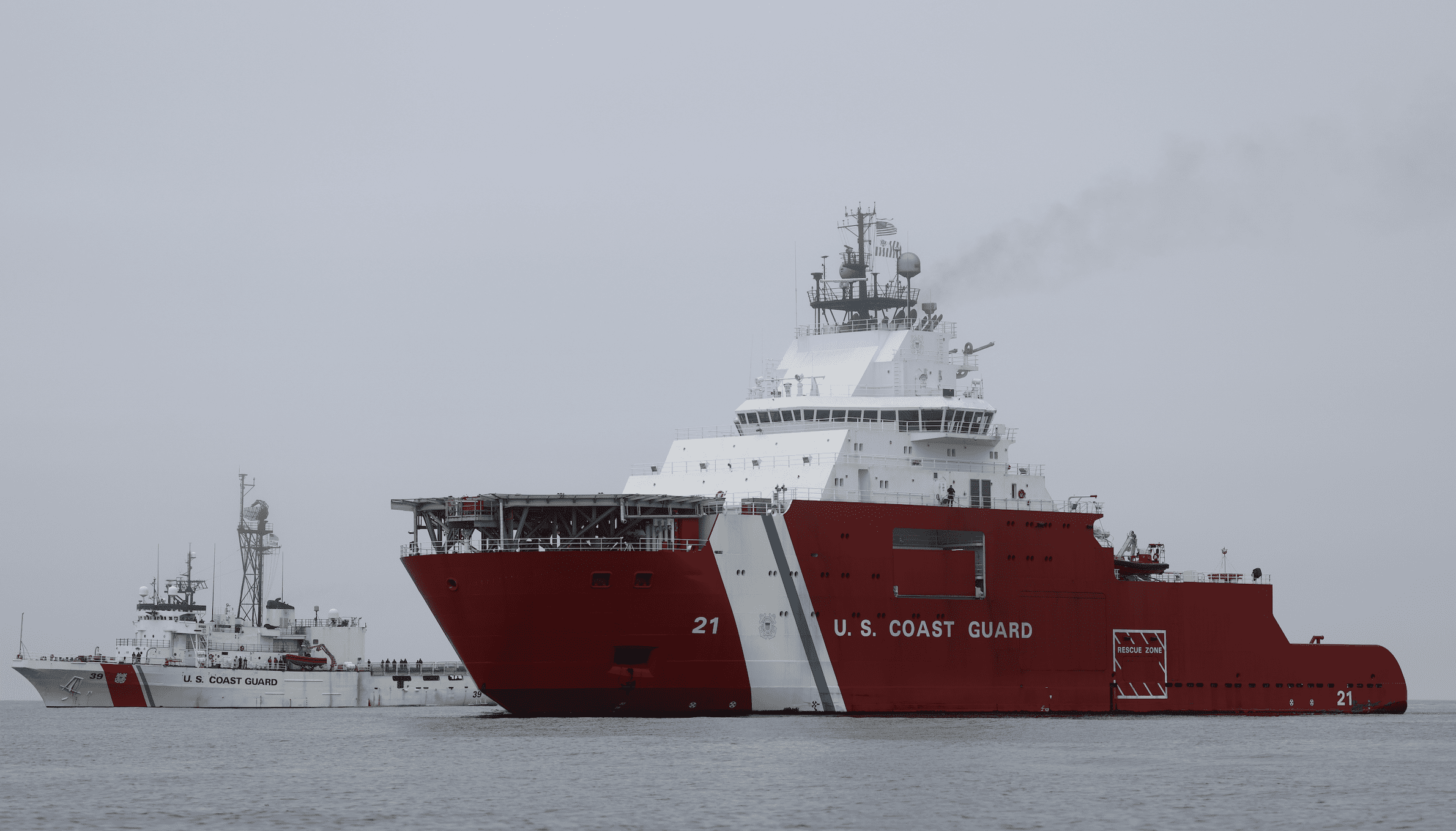by John Konrad (gCaptain) United States Coast Guard operations have never been more crucial. Ninety percent of global trade moves by sea, and more than twenty percent of the world’s population relies on the ocean as their primary food source. Maritime tensions are rising due to territorial disputes and strategic competition. From the South China Sea to the Red Sea, oceans and waterways face increasing challenges as adherence to international rules wanes. The U.S. and other nations grapple with shared maritime issues, including climate change, migration at sea, illegal, unreported, and unregulated fishing (IUUF), terrorism, transnational organized crime, and renewed great power rivalry.
Few in Washington doubt any of this, but fewer still are willing admit the US Coast Guard is struggling to meet its missions and needs more funding.
In what’s perhaps the most frank self-assessment we’ve seen from the U.S. Coast Guard, the 2024 Operational Posture (OP24) document doesn’t just catalog missions. It paints a stark picture of an agency balancing on the edge, tasked with defending a sprawling maritime domain, advancing cybersecurity, safeguarding the Arctic frontier, and responding to the resurgence of global competition—all while facing budgetary constraints that Vice Adm. Peter Gautier warned could render these ambitions impossible.
Gautier, the Coast Guard’s deputy commandant for operations, wasn’t mincing words when he presented the document this week at the Center for Strategic and International Studies. “We quite simply do not have enough funding to do all of this at the same time,” he stated, underscoring the Coast Guard’s position in a new era of high-stakes, transnational threats.
The message to lawmakers and the public: America’s sea service is already stretched thin, and without a substantial increase in resources, its reach—essential to U.S. influence across the Indo-Pacific, polar regions, and even cyberspace—will not match its grasp.
Unfortunately – while the US Army continues to grab for dollars – the sea services are reluctant to ask congress for more money.
According to Breaking Defense, Gautier explicitly said the statement is not “a pitch for money,” but he also admitted the USCG cannot continue on its current trajectory indefinitely without a budgetary boost — ideally to the tune of $6 billion annually.
The Indo-Pacific: Expanding Influence or Lost Ground?
The new Operational Posture document identifies the Indo-Pacific as the Coast Guard’s top priority, highlighting a shift toward a “target and interdict” strategy. The strategic repositioning goes beyond addressing fishing violations or smuggling—it’s about upholding an international maritime order under direct challenge. The Coast Guard is deploying National Security Cutters, Fast Response Cutters, and an advanced logistics enterprise to this contested region. There, it will serve as a bulwark against illegal, unreported, and unregulated fishing (IUUF), while also pursuing a broader mandate: preserving open sea lanes and regional stability in the face of increasing Chinese assertiveness.
The problem is, despite the pivot to the Pacific being first announced during the Obama administration, the current Biden-Harris administration hasn’t seemed to receive the memo. Instead, they’re focusing increasingly on tensions in Ukraine and the Middle East.
The real challenge lies in sustaining this expanded mission set with limited White House focus on Pacific tensions. Even if Congress approves an additional $6 billion annual increase, keeping pace with China—which operates a much larger Coast Guard fleet and a Maritime Militia—in one of the world’s busiest and most contested maritime regions demands more than mere budget adjustments. The Coast Guard must ramp up its operational tempo, support, and coordination with allies. This isn’t simply about extending a hand to regional partners—it’s about forging an agile network of maritime actors to counterbalance a high-stakes geopolitical chess game.
Arctic & Antarctic: Understaffed, Underfunded, Unprepared?
The Coast Guard’s Arctic aspirations highlight another vulnerability. The document lays bare an underwhelming fleet of just two icebreakers, one of which—the USCGC Polar Star—is pushing 50 years of service and the other – USCGC Healy – recently caught fire. The melting Arctic ice is opening strategic routes that could reshape global trade, but the Coast Guard’s inability to operate persistently in these waters places the U.S. at a stark disadvantage, particularly as Russia and China steadily increase their own Arctic capabilities and actively push into waters off Alaska’s coast.
The Operational Posture outlines plans to acquire a commercial icebreaker as a temporary stopgap, but the ultimate goal is a new Polar Security Cutter fleet with eight operational icebreakers. The pressing question is: Will policymakers fully grasp the Arctic’s escalating importance in national security and commerce, and act before the Coast Guard’s polar presence becomes merely symbolic? At stake is U.S. influence over an increasingly strategic frontier—and the ability to operate effectively in a warming region where maritime interests are rapidly intensifying.
Cybersecurity: The Unseen Frontline in Maritime Defense
Perhaps most compelling is OP24’s candid assessment of the Coast Guard’s cybersecurity ambitions in the wake of an executive order to boost protection of ships and ports. Cyber threats have evolved into a silent menace, as vulnerable port infrastructure and exposed data pipelines open doors to espionage, sabotage, and even outright economic disruption. The Coast Guard’s response—a trio of Cyber Protection Teams and a Cyber Mission Team in conjunction with U.S. Cyber Command—heralds a new chapter for the service, where the “digital MTS” is seen as equally critical to the U.S. economy as its physical counterpart.
Yet the cyber component isn’t just technical; it’s existential. The U.S. Marine Transportation System (MTS), supporting over $4.6 trillion in economic activity, is more connected than ever and dangerously exposed to adversaries. The Operational Posture calls for heightened cybersecurity standards and increased collaboration with CISA, making it clear that the Coast Guard sees the digital maritime domain as one of the service’s primary fronts. The critical risk here is clear: should budget shortfalls compromise cyber capabilities, the nation’s ports, ships, and maritime trade could become easy prey to hostile actors who won’t need to step foot on a vessel to inflict catastrophic damage.
The Western Hemisphere: Crime, Migration, and the Coast Guard’s Multi-Mission Strain
The Coast Guard has always played a role in curbing drug smuggling and human trafficking, but the Operational Posturehints at an agency caught between new threats and old limitations. In the Caribbean and Eastern Pacific, the Coast Guard is grappling with a surge in fentanyl smuggling, which Vice Adm. Gautier calls a “massive problem.” Transnational criminal organizations (TCOs) have grown sophisticated, exploiting maritime channels to transport drugs and precursors. As the service ramps up its collaboration with allies, especially the Mexican Navy, it’s relying on intelligence sharing and training to extend its reach, countering TCO influence with a comparatively lean operational budget.
In addition, the Coast Guard faces a humanitarian challenge: migrants escaping political and economic upheaval in Haiti, Cuba, and Venezuela, risking dangerous crossings in record numbers. The Coast Guard’s role in interdicting these flows and preserving life at sea is part of its DNA, but as missions pile up, it’s unclear how the service will manage both the acute need for counter-TCO operations and its long-standing responsibility to migrants.
Domestic Failures
The document also has significant omissions. It fails to address the Coast Guard’s reduced capacity for domestic rescue operations during this hurricane season, stemming from helicopter maintenance issues and the closure of boat stations and cutters due to recruiting shortages.
Rather than directly addressing the inadequate response to disasters, particularly in North Carolina, the document obscures this critical issue with vague language such as:
“Service-wide personnel shortages have required adjusting the workload across our small boat stations through the Force Alignment Initiative, which began in 2023. This has resulted in temporarily modifying station force structure and new concepts of operations to assure that we continue to achieve SAR standards for response to mariner distress. These concepts will continue to evolve to enhance SAR while we restore our workforce levels.”
It fails to address some other massive failures, such as the Coast Guard’s stringent training requirements for U.S. Merchant Mariners, the difficulty in advancing from seaman to officer ranks, and its substantial backlog of medical evaluations. These issues collectively contribute to a mariner crisis that has forced the U.S. Navy to sideline seventeen ships.
Also read: U.S. Merchant Mariner Shortage Demands Action Now by Bruce Kimbrell
The document also fails to address the Army’s decision to sell off its watercraft fleet and reduce Army Corps of Engineers waterway funding. These actions have forced the already strained Coast Guard to bear the brunt of responsibility for major incidents like the Baltimore Bridge collapse.
Also read: It Looks Like We Are Going To Have to Swim For It – The End of the Army’s Navy
A Financial Crossroad: The Case for $6 Billion—And What’s at Stake If It Doesn’t Come
By releasing Operational Posture 2024, the Coast Guard has done more than present its case for funding; it’s suggested a strategic ultimatum. The reality is as Gautier explained: there is no “more with less” left to squeeze out. This annual $6 billion is a foundation, not a luxury. Without it, the service risks becoming an agency forced to choose between Arctic presence and countering IUUF in the Pacific; between cybersecurity and drug interdiction; between patrolling U.S. waters and responding to surges in the global migration crisis.
In Gautier’s words, the Coast Guard’s current path is unsustainable, and as its missions balloon, so too will the financial and operational stakes. As the 2024 elections loom, Congress and the next administration faces a clear choice: invest in a Coast Guard that’s built to defend America’s evolving maritime interests or watch the nation’s security and maritime supremacy falter at sea. If there’s one message the Operational Posture 2024 imparts, it’s this: the Coast Guard is prepared to play a decisive role in the world’s most contested regions, but only if Washington understands the urgency of funding this mission.
In a world where gray-zone tactics dominate, the Coast Guard’s mandate is clear. The only question left is whether lawmakers will fully understand the price of America’s future maritime power—before the bill comes due in oceans we can no longer control.
The sobering reality is that, while the document’s candor is commendable, it falls short in several critical areas. It glosses over significant issues like the merchant marine crisis, downplays crucial problems such as helicopter maintenance groundings during hurricane response, and fails to challenge other services’ encroachment on Coast Guard responsibilities—as seen in the Baltimore incident where the Coast Guard shouldered the Army and DOT’s response costs. Perhaps most notably, it stops short of making a direct appeal for increased funding.
With geopolitics unraveling globally and more serious incidents and disasters occurring domestically, the United States needs a stronger Coast Guard. However, it’s unlikely anyone will listen if Caost Guard Admirals like Gautier and Commandant Linda Fagan don’t ask for the billions more they desperatly require.

 Join The Club
Join The Club











